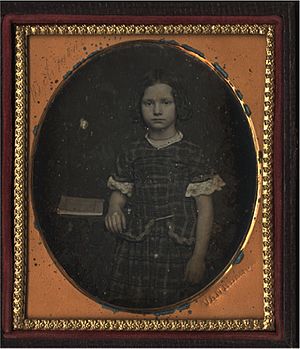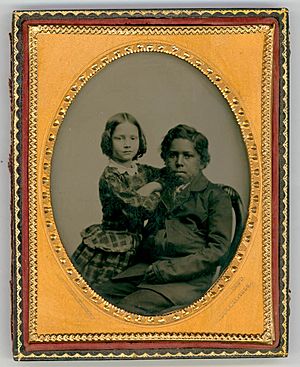Mary Mildred Williams facts for kids
Mary Mildred Williams (born Botts, around 1847 – 1921) was born into slavery in Virginia. She became well-known as an example of a "white slave" in the years leading up to the Civil War.
In 1855, her father, who had escaped slavery, bought his family's freedom. He got help from people who wanted to end slavery, called abolitionists. Mary, her mother, and her siblings then joined him in Boston, Massachusetts. When Mary arrived in Boston at age seven, her photograph was shared widely. Her appearance surprised many, as people usually imagined enslaved people differently. The young girl traveled with Charles Sumner, a US Senator from Massachusetts and a leading abolitionist. He used her story to show people in the North how unfair slavery was. He also raised awareness and money for the movement to end slavery. Williams was compared to Ida May, a character in a popular book. Ida May was a white girl who was kidnapped and sold into slavery.
Contents
Early Life and Family
Mary Mildred Botts was born in 1847 in Virginia. She was the second child of Seth Botts and Elizabeth (who was born Nelson). Both of her parents were enslaved. Elizabeth's father was white. Seth and Elizabeth got married in the early 1840s. Mary had an older brother named Oscar and a younger sister named Adelaide (also called Rebecca).
When Mary was born, her mother, brother, grandmother, and aunts were enslaved in Prince William County, Virginia. This was near the village of Washington. Her father was enslaved in a nearby area called Stafford County. Mary's mother, Elizabeth, was the daughter of Prudence and a white man named Thomas Nelson.
Mary was seven years old when she became free in 1855. Her mother and siblings also gained their freedom. Her father had escaped Virginia earlier and settled in Boston, Massachusetts. Her mother moved the family to Boston to be with her husband, who changed his name to Henry Williams. Between 1855 and 1860, all family members changed their last name to Williams. In the summer of 1860, Mary's older brother Oscar died from tuberculosis, a serious illness.
Gaining Freedom
In 1855, Mary, at age seven, became free. This happened because of her father, Seth Botts, who had escaped slavery. Seth had settled in Boston in 1850. He changed his name to Henry Williams. For the next four years, he worked to get help from important abolitionists. These were people who strongly believed slavery should end.
With money from his wealthy supporters, Henry Williams bought his family's freedom from their owner. During this process, Henry's daughter, Mary Mildred Williams, caught the attention of Senator Charles Sumner. Senator Sumner was a powerful voice in the abolitionist movement.
A Symbol for Abolitionists
On March 1, 1855, a letter from Charles Sumner was published in the New-York Daily Times. This letter, written on February 19, came with a photograph of Mary Williams. In the letter, Sumner described Mary. He said she was "a most beautiful white girl, with high forehead, straight hair, intellectual appearance, and decidedly attractive features." Later, on March 9, 1855, reporters for the New-York Daily Times said they were "astonished" that Mary had ever been a slave.
In early 1855, articles about Mary Williams appeared in the Boston Telegraph and New York Times. Copies of her photograph were shared everywhere. After her photo became famous, she traveled with Senator Charles Sumner. They went on a tour to raise awareness and money for the cause to end slavery.
Mary's photo and tour made her well-known. People compared her to Ida May, a made-up character in a popular book. Ida May was a white girl who was kidnapped and forced into slavery. A writer in Frederick Douglass’ Paper said Mary was "perfectly white." This made her story very exciting. Abolitionists used Mary's light skin to get people's sympathy. They wanted to show Northerners that any child, no matter how they looked, could be taken and made a slave. This helped people understand the danger of slavery.
Later, in 1856, Senator Sumner was attacked in the Capitol building because of his strong anti-slavery speeches.
Adult Life and Legacy
By 1865, Mary Williams had moved to Lexington, Massachusetts. She lived there with her parents and sister. Five years later, she was living with her mother and sister in Hyde Park, a part of Boston. It is not clear why her father did not join them there.
In the 1870 census, Mary, her mother, and her sister were listed as white. Both Mary and her mother identified as white women for the rest of their lives. When her mother died in 1892, Mary listed her mother's maiden name as Nelson, which was her white father's last name.
Mary Williams never married or had children. She worked as a clerk at Boston's Registry of Deeds, which is an office that keeps records of property. She worked there until at least 1900.
She rented an apartment in Boston and, according to the 1900 census, she lived there with her "partner," Mary Maynard. Maynard worked as a bookkeeper and a probation officer. She came from Irish and English families.
Mary Williams died in 1921 and was buried in Boston. Her story remains an important part of understanding the fight against slavery in the United States.
Images for kids
See also
- White slave propaganda
- Garafilia Mohalbi





